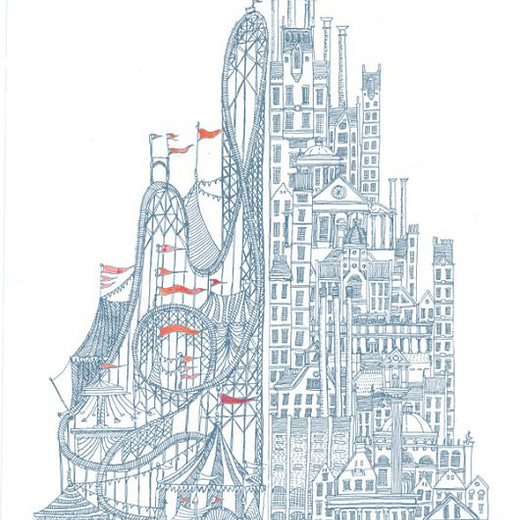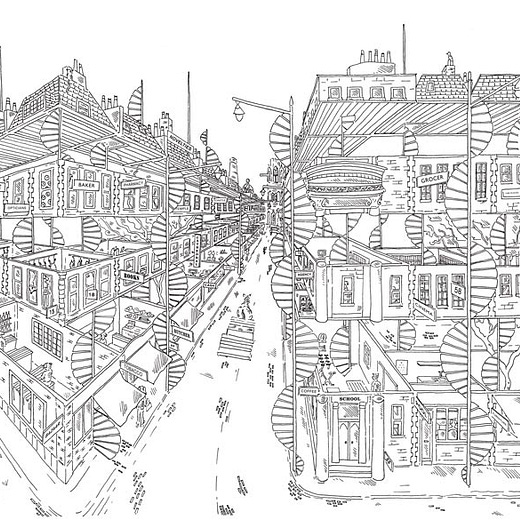Thriving Lessons From The City of Yazd
What do cities tell us about inner narratives and the generative potential of the present?
Greetings from Tehran,
Today, I’m looking to an old city (Yazd) as an inspiration for generative change and an enabler of our inner narratives.
In this post:
Cities and Our Inner Narratives
Generative Potential Within Present
The city of Yazd as a Metaphor for Generative Change
What is Appreciative Intelligence?
Think about this question:
How can visiting old cities and ancient architectures give you new perspectives and understanding about self, life, and collective changes?
Cities and Our Inner Narratives
One of my top favorite books is Invisible Cities, a novel by Italian novelist Italo Calvino.
The book explores imagination and the imaginable through the descriptions of cities by an explorer, Marco Polo. The book is framed as a conversation between the elderly and busy emperor Kublai Khan, who constantly has merchants coming to describe the state of his expanding and vast empire, and Polo. The majority of the book consists of brief prose poems describing 55 fictitious cities that are narrated by Polo, many of which can be read as parables or meditations on culture, language, time, memory, death, or the general nature of human experience.1
Calvino put the concept of traveling and different forms of cities to give readers access to themselves and open a new window of self-understanding. Cities represent our complex living system and show how we, as social creatures, connect, reframe our problems and find solutions to our daily lives. Cities are boundaries that give us a shared narrative for living. Part of our self-definition comes from the location where we live.
Read this article on: How do places shape who we are.
If I ask: "Who are you?"
You can answer this question with the different roles you have as a father, mother, and expert in any field. The definition of your identity will change based on where you are physically located. I mean, changing the geography will change our relationships, our sights, and our experiences. When environment change, our narratives changes.
Now, answer this question from your residency point of view. Describe yourself as a person who lives in London. Kuala Lumpur, Amsterdam, Tehran, Vancouver, etc. (I know there are readers from these cities.)
Suppose I describe myself as a person who lives in big busy Tehran.
In that case, I'm defined by the mountains around Tehran, the air pollution, the jammed traffic of everyday streets, the contrast of old and modern buildings, and lots of Platanus trees. Tehran, as a metropolis, every day shapes how I behave, how I choose, how I act. Accessing mountains defines a different kind of experience in terms of relaxation than someone in another city who has access to the sea. People from other towns come to Tehran to find more significant work opportunities. They seek the quality of life, and at the same time, some people living in this busy city seek opportunities to migrate from it to find a calm place. When I listen to my inner narrative, it's something like between staying and leaving. I love this city, and at the same time, I want to leave the pollution and busyness.
Cities represent our collective ideas and actions and, at the same time, are shaping our inner narratives.
Think about the location you are living in; what narratives evoke in you?
Generative Potential Within Present
The first time I visited the city of Yazd, at the heart of the desert, it was a profound experience because I was walking in a different kind of city.
While I was walking in the roofed alleys, I realize that how people from years ago have found a way to protect themselves from the sun's heat, and when I entered houses with wind-catchers, and I realized that how they could manage wind and lead it to homes to make their places cool.
Where is Yazd?
The City of Yazd is located in the deserts of Iran, close to the Spice and Silk Roads. It is a living testimony to the intelligent use of limited available resources in the desert for survival. Water is brought to the city by the qanat system. Each district of the city is built on a qanat and has a communal center. Buildings are built of earth. The use of earth in buildings includes walls and roofs by the construction of vaults and domes. Houses are built with courtyards below ground level, serving underground areas. Wind-catchers, courtyards, and thick earthen walls create a pleasant microclimate. Partially covered alleyways together with streets, public squares, and courtyards contribute to a pleasant urban quality. The city escaped the modernization trends that destroyed many traditional earthen cities. It survives today with its traditional districts, the qanat system, traditional houses, bazaars, hammams, water cisterns, mosques, synagogues, Zoroastrian temples, and the historic garden of Dolat-Abad. The city enjoys the peaceful coexistence of three religions: Islam, Judaism, and Zoroastrianism.2
Walking in this city constantly inspired you to be curious about the creative power of human beings. The city is full of places that touch the aesthetic side of the visitor. While you walk and visit, at the same time, you want to take photos not to miss any part or place. You want to keep the moments in pictures. Freeze them. You want to freeze your emotions at a particular moment in time. As you take pictures, you know you have to leave this city sooner or later, and this is why you want to take more photos. The images give you the opportunity of imaginary travel to the town after you left it.
The more I walked in the city, the more I asked myself how old generations in this city could build such a structure? How could they not just survive but thrive? How could they be creative that took advantage of their limitations and made a structure to serve them? What qualities did those people have? How could they collaborate to get such innovative results?
The city of Yazd as a Metaphor for Generative Change
In many workshops and intro speeches, I use the architecture in Yazd as a metaphor for finding the opportunity to thrive even in hard times. It's a symbol of reframing. In the old days, people who migrated there had seen a possibility at the heart of the desert.
Thinking about Yazd can have lessons:
Humans are adaptable and can find ways to any living condition.
Limitations are the source of creativity.
What you create today is natural. It's not a masterpiece because it's in response to your current needs. Other people may call your work creative. (Old generations in Yazd did not build the city because of creativity's sake. They should react to their living condition.)
In every situation, we can find solutions to challenging problems. (Yazd is the representation of our collective power. When we can work together, we can design creative solutions for our limitations)
We can reframe a problem and be part of the solution. (Qanat system to manage the water, Architecture of buildings to provide quality of life, and roofed passages to protect viators are the symbol of reframing.)
I insist on the structure of Yazd as a collective action to the living condition because the shared spaces like passages are well designed and was an act for the good of the whole, not individuals or families. Even the way they managed the water was a collective approach for the good of the whole with a vision to sustain the resources for the next generations.
In my travel to the Yazd, I remembered the concept of Appreciative Intelligence by Tojo Thatchenkery and Carol Metzker.
What is Appreciative Intelligence?
Appreciative Intelligence is the ability to perceive the positive inherent generative potential within the present. Put in a simple way; Appreciative Intelligence is the ability to see the mighty oak in the acorn. Metaphorically, it is the ability to see more than the present existence of a small capped nut. It is the capacity to see a strong trunk and countless leaves as emerging from the nut as time unfolds. It is the ability to see a breakthrough product, top talent, or valuable solution of the future that is currently hidden in the present situation.3
Lessons from Yazd and the definition of appreciative Intelligence can lead us to think about more than the present. While we are living in the present, we are actively shaping our future. We are co-creating our future with the people we are in a relationship with, and at the same time, the emerging future is defined by the environment we live in. It's a constant construction of life narrative. It's not a personal act but a collective one. Like people in Yazd, maybe we need to see more than the present. The emerging future is constantly unfolding.
Which city inspires you?
What kind of inspiration does it give you?
Back to Invisible Cities
In the invisible cities novel, Marko Polo describes a charming city called Zora. He mentions Zora is such a beautiful city that you will remember every detail of it at first sight. But the town destroyed because it wanted to keep its beauty in memory of visitors and resisted change.
Have great week ahead,
If you find this post useful please share with your friends.












I had a strange sensation with your writing. In Tehran and about the strange sense of his problems, and at the same time loving a city that is my hometown.
👏🏻👏🏻👏🏻